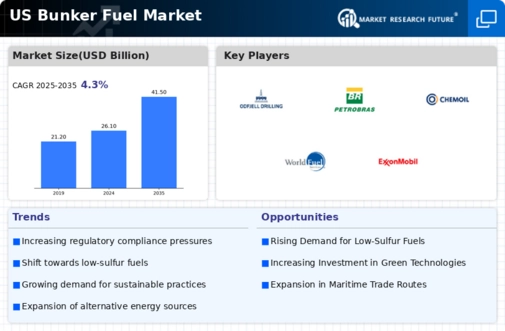The US Bunker Fuel Market is characterized by a competitive landscape that is influenced by various factors, including regulatory changes, fluctuations in crude oil prices, and advancements in shipping technology. This market encompasses a wide range of fuel options used primarily for marine vessels, and it is subject to strict environmental regulations aimed at reducing emissions and promoting sustainability within the maritime industry. Competition is defined not only by the pricing strategies employed by various players but also by the quality of the fuel offered, logistical capabilities, and customer service.
The landscape has also seen an increase in the adoption of alternative fuels as stakeholders seek to meet stringent environmental standards while maintaining operational efficiency. Understanding this competitive framework is essential for companies looking to establish or enhance their foothold in this vital sector of the energy market. Odfjell, as a prominent player within the US Bunker Fuel Market, has established a strong market presence characterized by its expertise in the supply chain and logistics of marine fuels.
The company benefits from its extensive network and strategic partnerships, which allow it to efficiently supply high-quality bunker fuels to various ports across the United States. Odfjell's strengths lie in its operational efficiency and commitment to sustainability, which resonate with regulatory trends and the evolving needs of customers looking for cleaner energy alternatives. Furthermore, Odfjell's focus on innovation in fuel formulations helps it to stay competitive and meet stringent environmental regulations, thereby enhancing its reputation among industry stakeholders and securing long-term customer relationships.
Petrobras is another significant contributor to the US Bunker Fuel Market, renowned for its wide range of key products and services tailored for the maritime industry. The company has established a formidable presence in this market, leveraging its state-of-the-art refining capabilities and a robust distribution network across the United States. Petrobras offers various grades of bunker fuel, which are designed to meet the diverse needs of shipping companies operating in a highly regulated environment. This strength is further amplified by strategic mergers and acquisitions that have allowed Petrobras to expand its market reach and operational competencies.
The company's commitment to research and development fosters innovation in fuel formulations, enabling it to provide cleaner and more efficient fuel options. Overall, Petrobras's competitive position in the US Bunker Fuel Market is marked by its ability to deliver high-quality products coupled with a solid reputation for reliability and sustainability in an increasingly competitive landscape.






